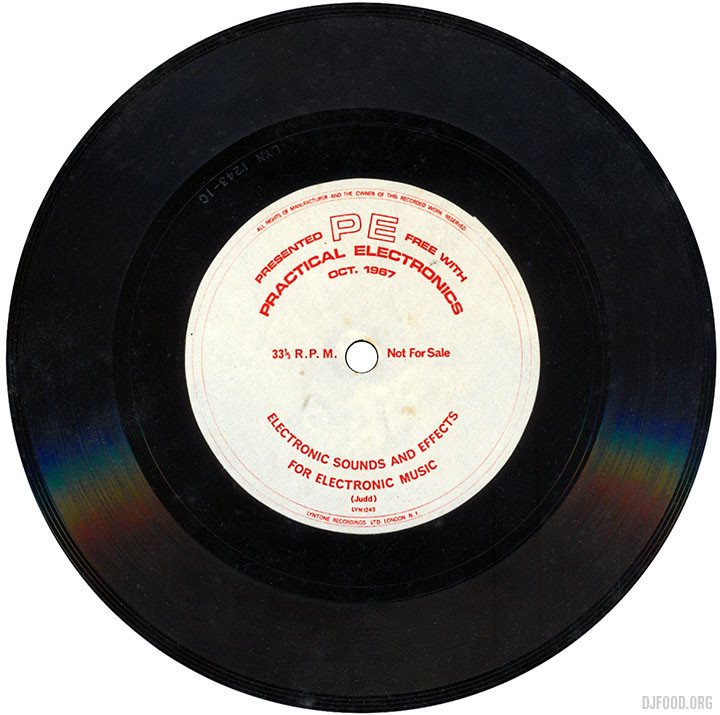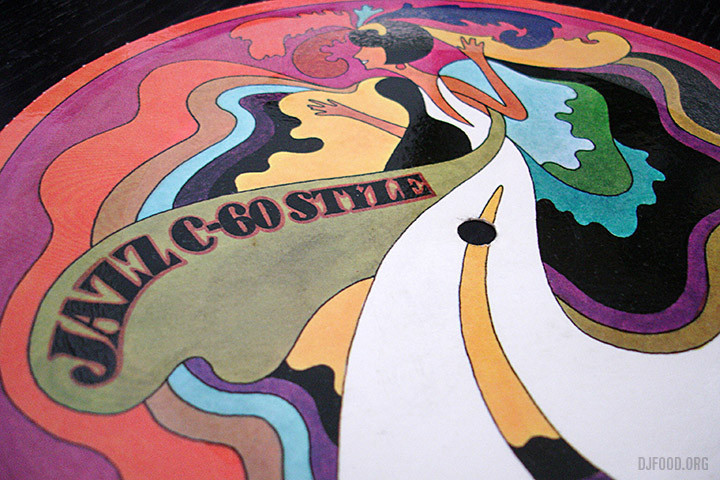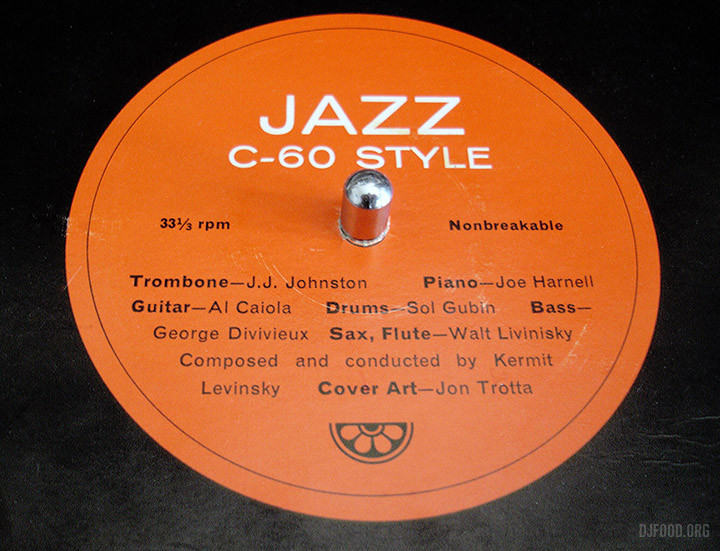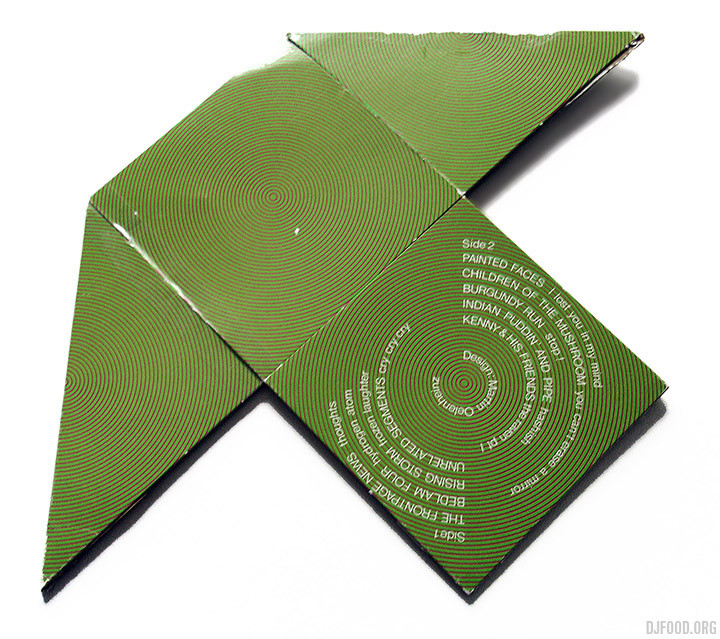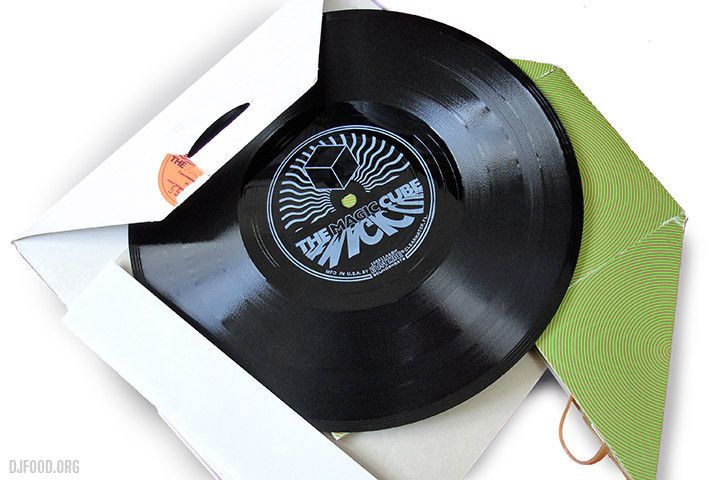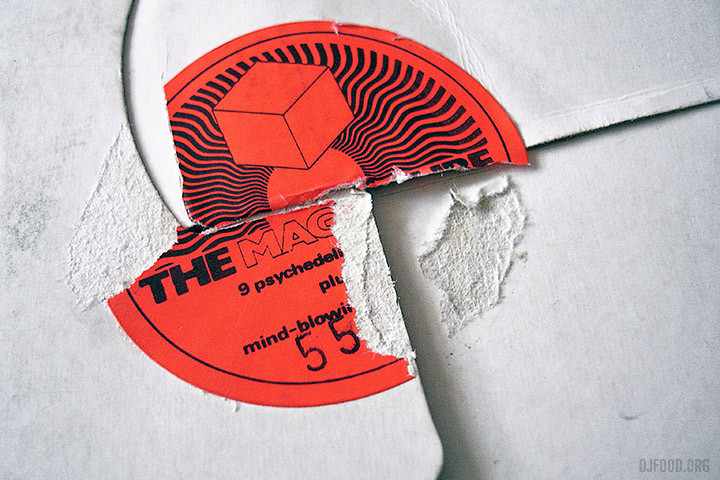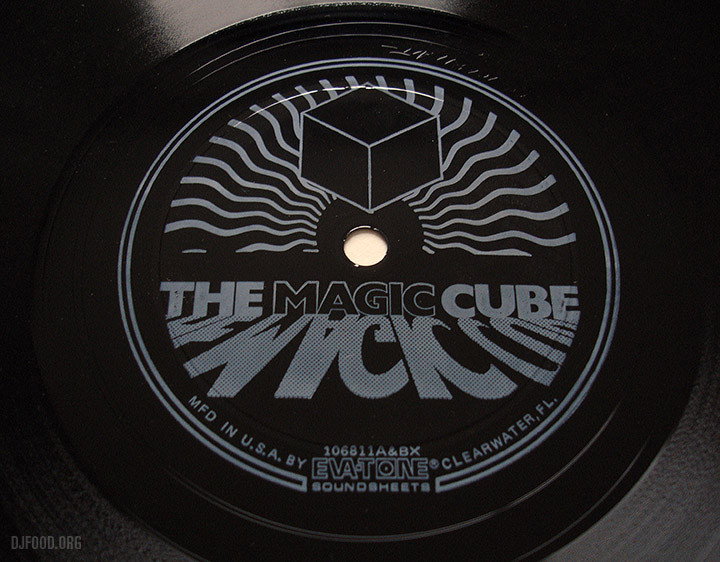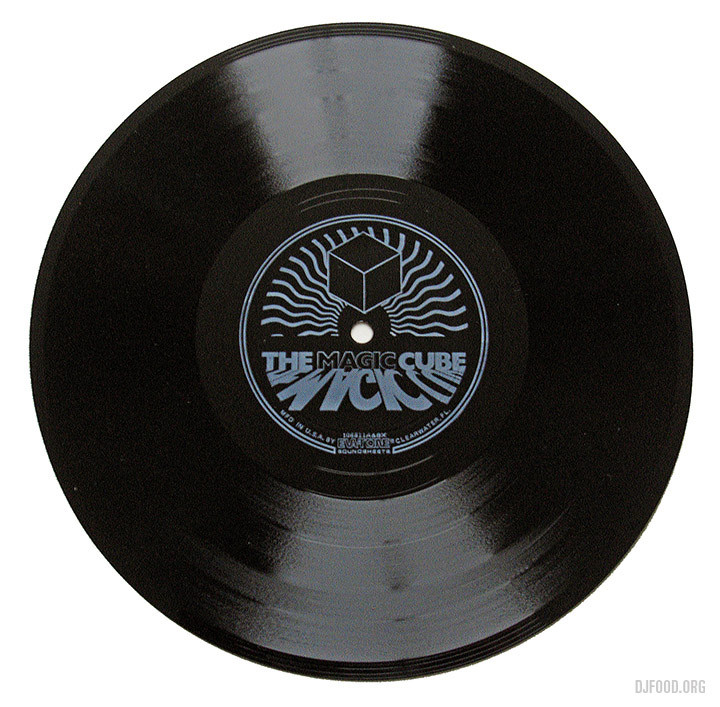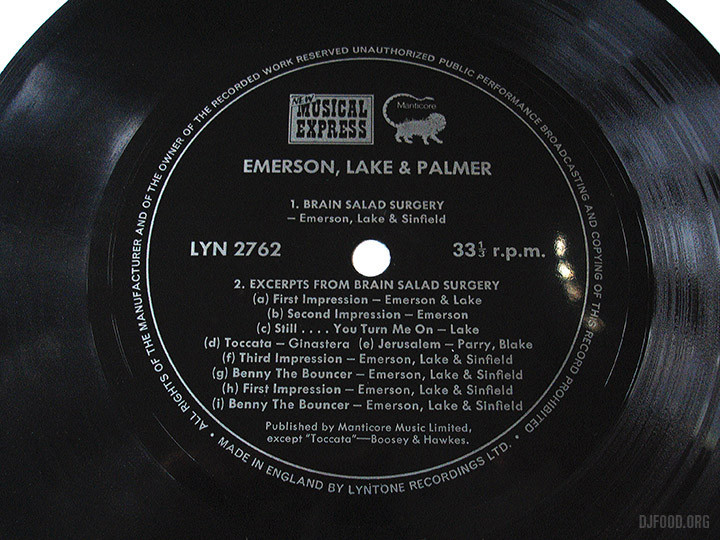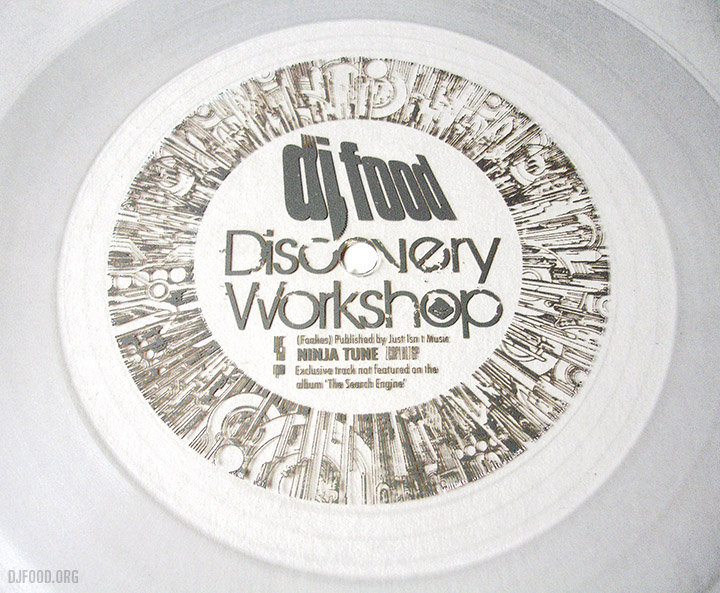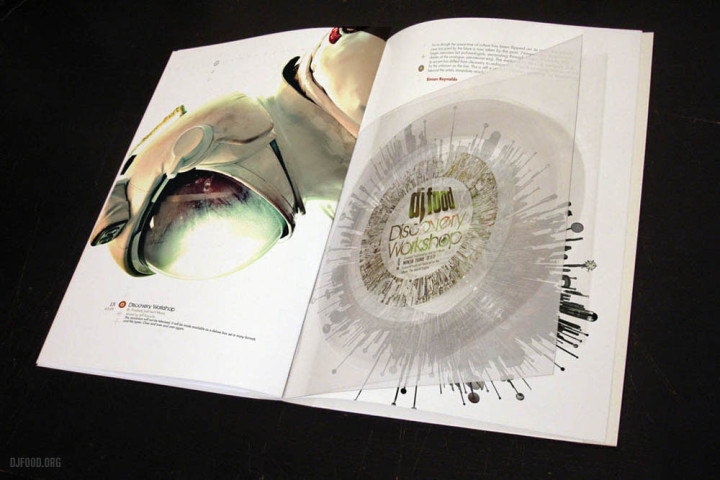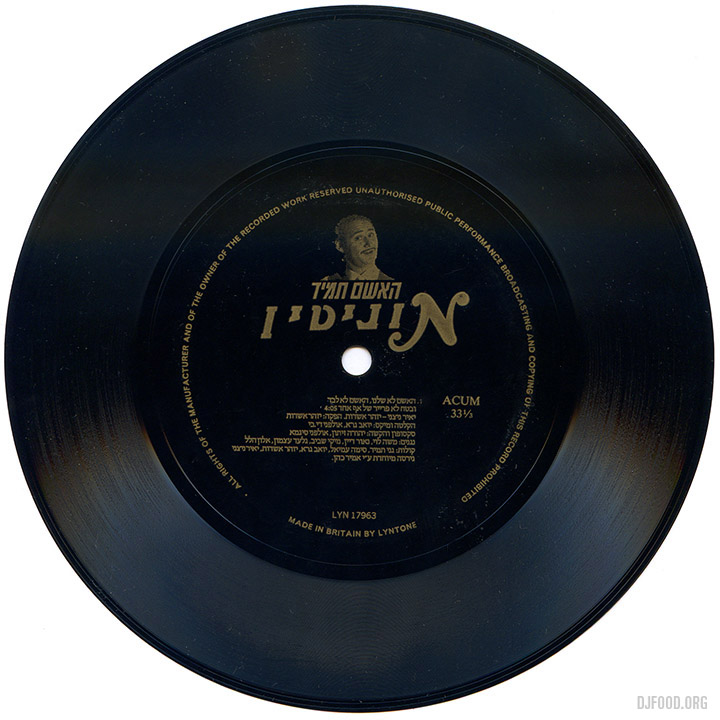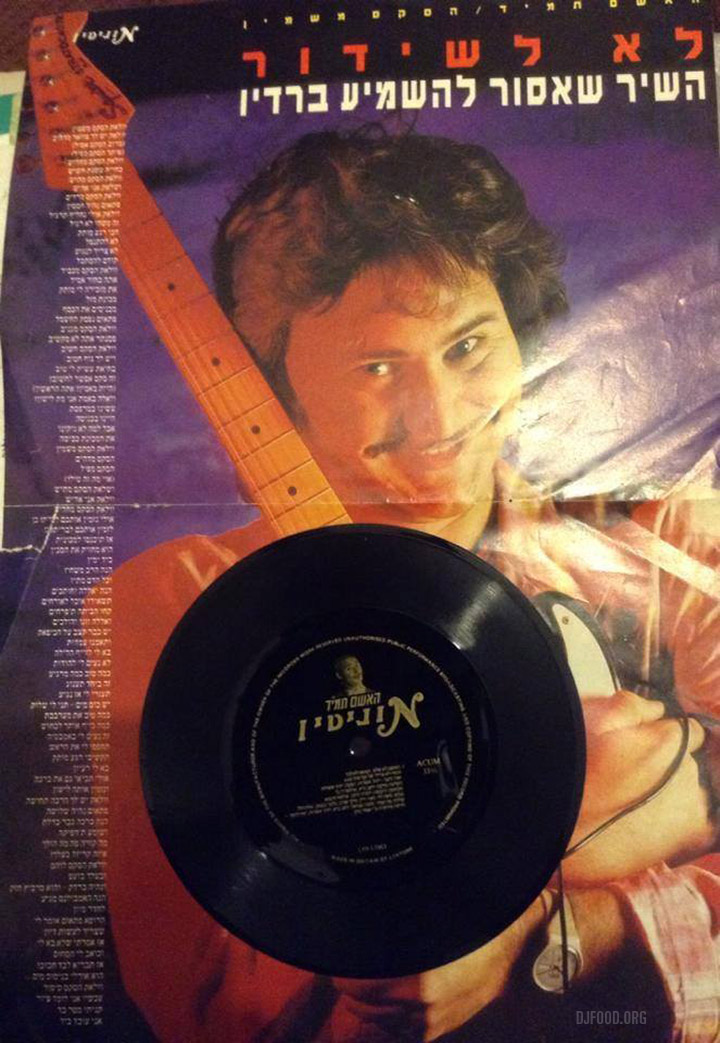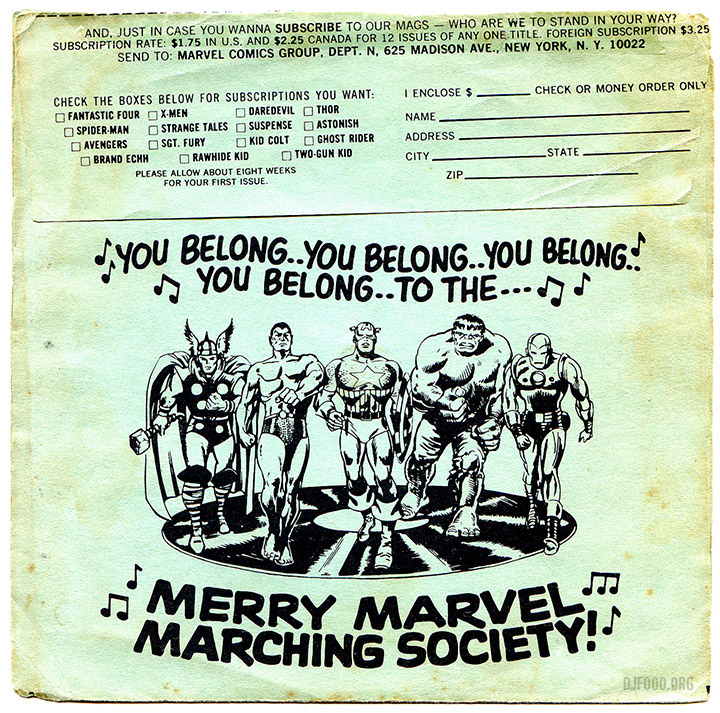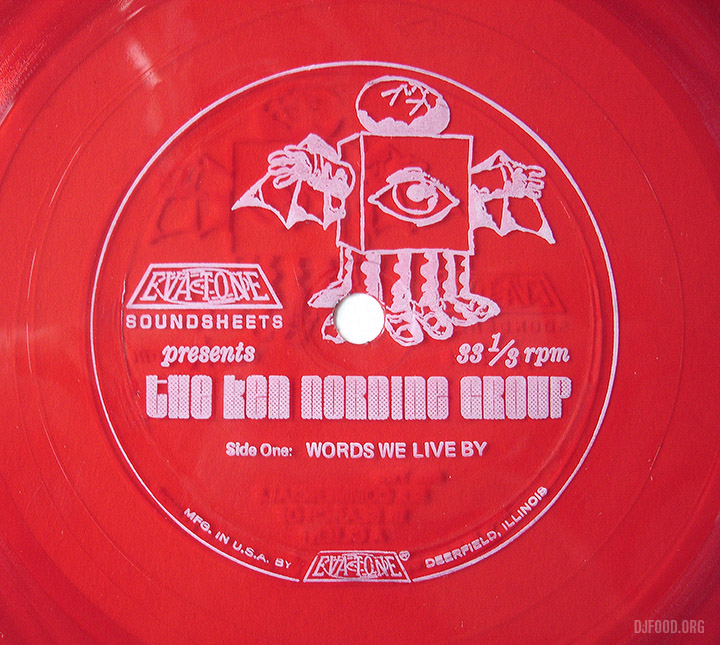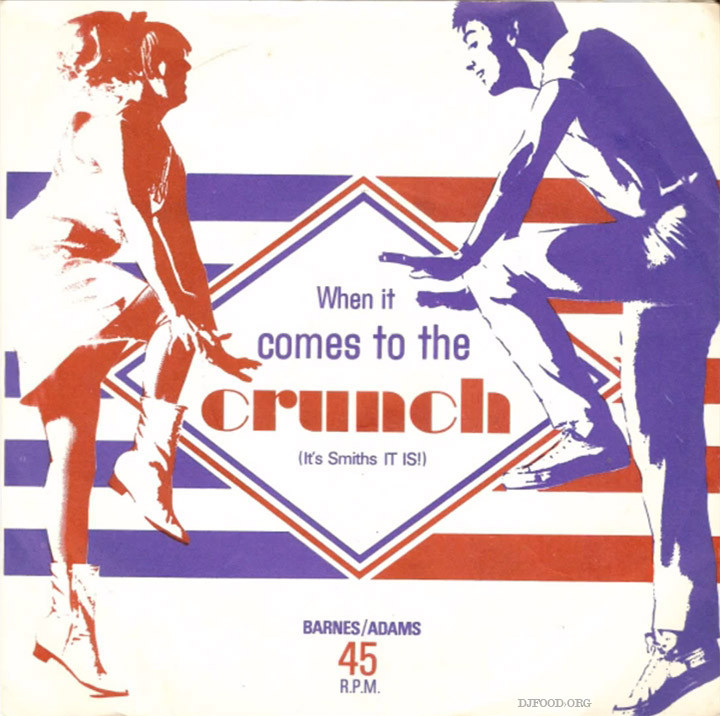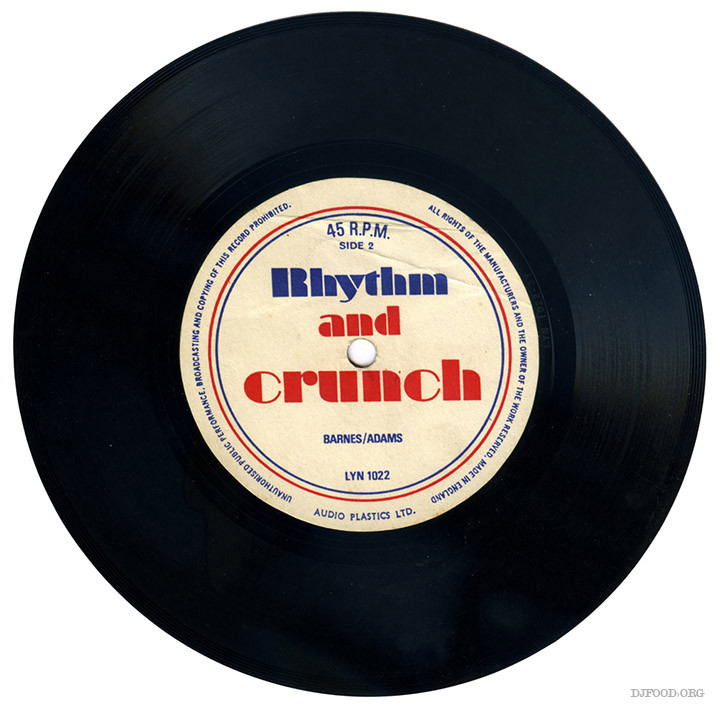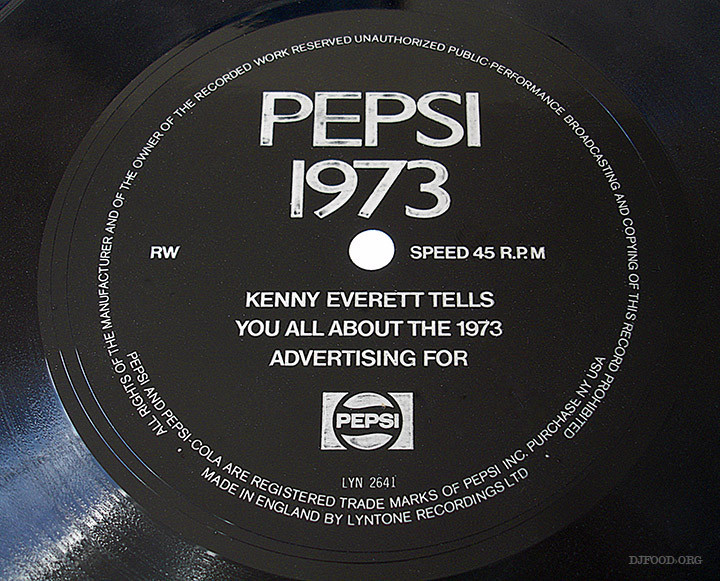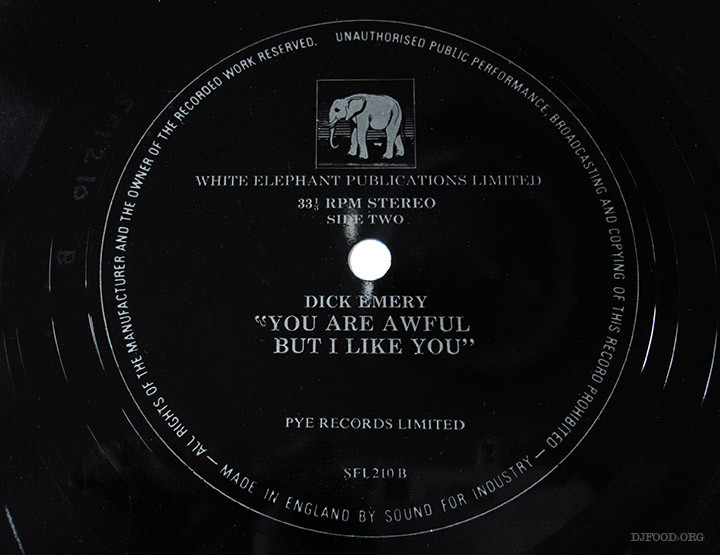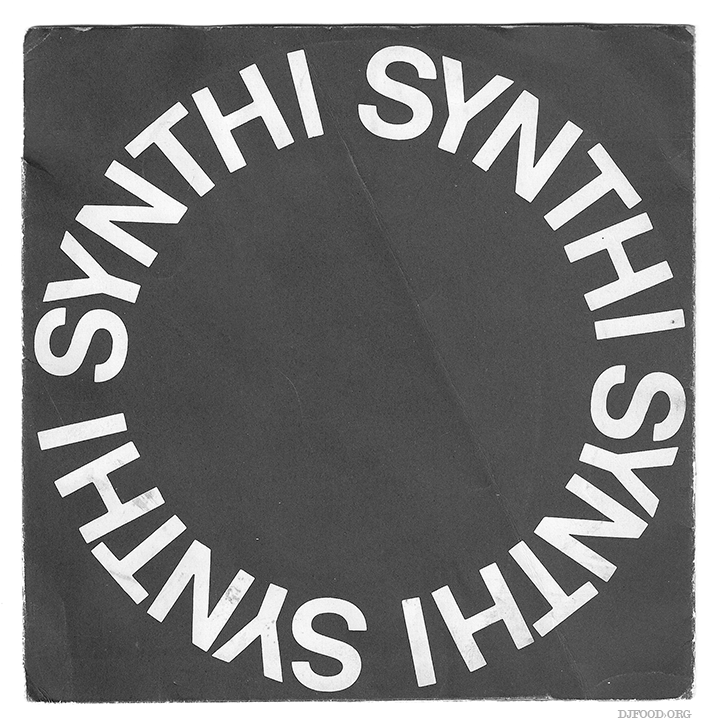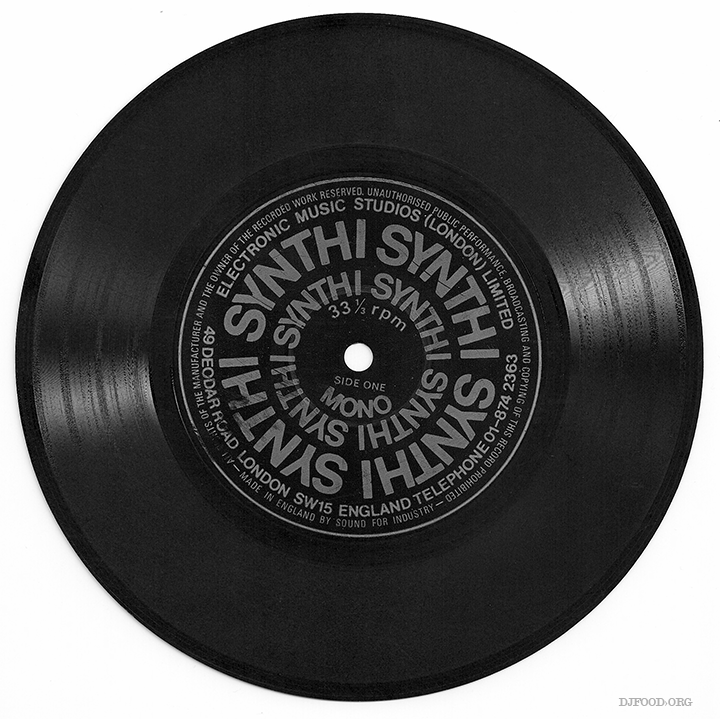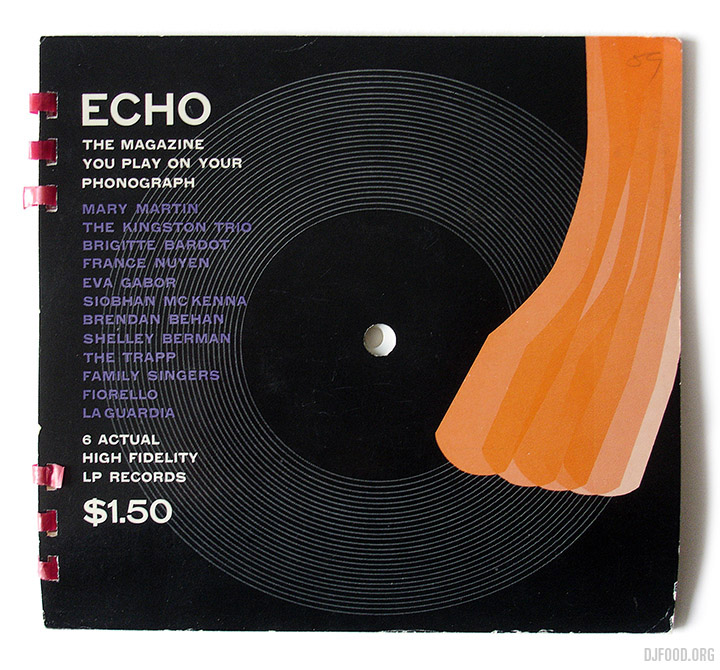 Echo – ‘the magazine you play on your phonograph’ – was first published in 1959 and came with 5 or 6 flexi discs fixed inside each issue, mostly containing music and interviews with the subjects profiled within. The ring-binder design let each page fold back under the last and a spindle hole through the centre meant that you could place the whole magazine on the turntable to play each disc.
Echo – ‘the magazine you play on your phonograph’ – was first published in 1959 and came with 5 or 6 flexi discs fixed inside each issue, mostly containing music and interviews with the subjects profiled within. The ring-binder design let each page fold back under the last and a spindle hole through the centre meant that you could place the whole magazine on the turntable to play each disc.
An 8″ x 8″ quarterly publication that ran for at least 4 issues as far as I can tell (of which this is #3), it had beautiful page layouts courtesy of Designers’ Collaborative from New York and United Artists served as the agent supplying the entertainment talent. This one features music and interviews with The Trapp Family / Mary Martin / Brigitte Bardot / France Nuyen / Eva Gabor / Siobahn McKenna / Brendan Behan / a Shelley Berman monologue / an interview with The Kingston Trio / Fiorello La Guardia reads the comics and an advert for Springmaid Fabrics.
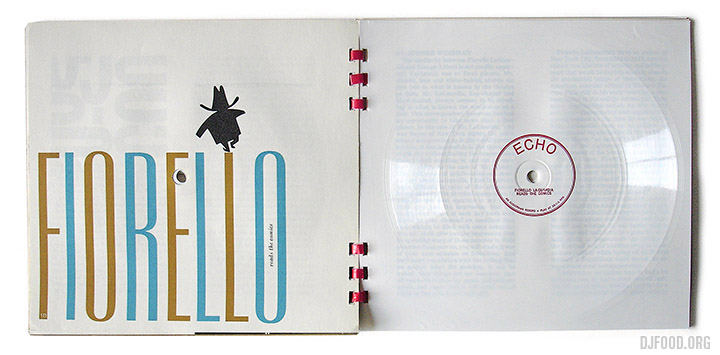
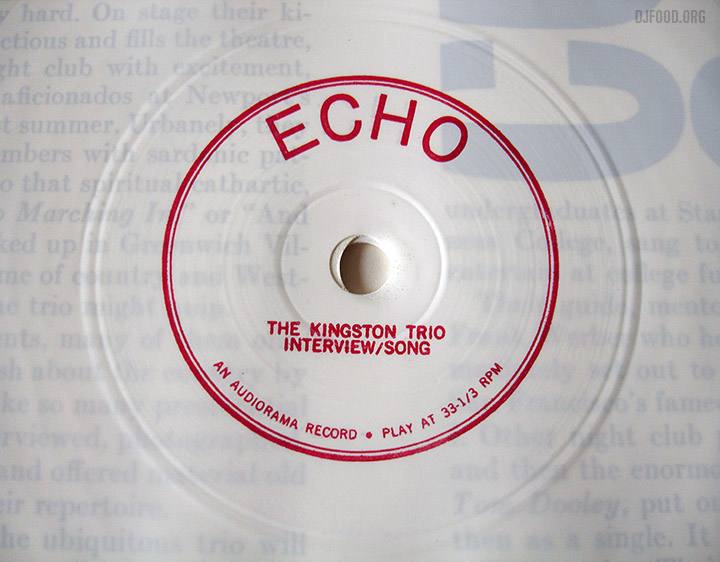

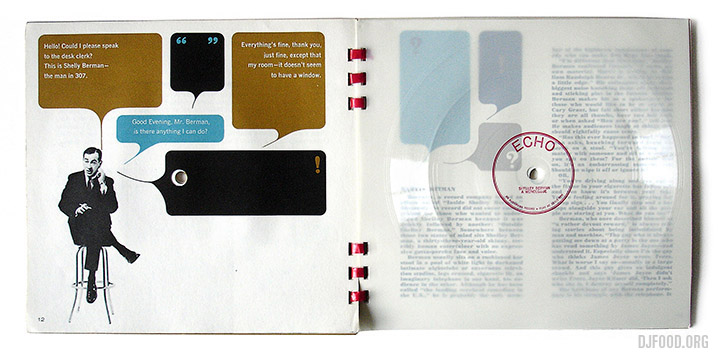
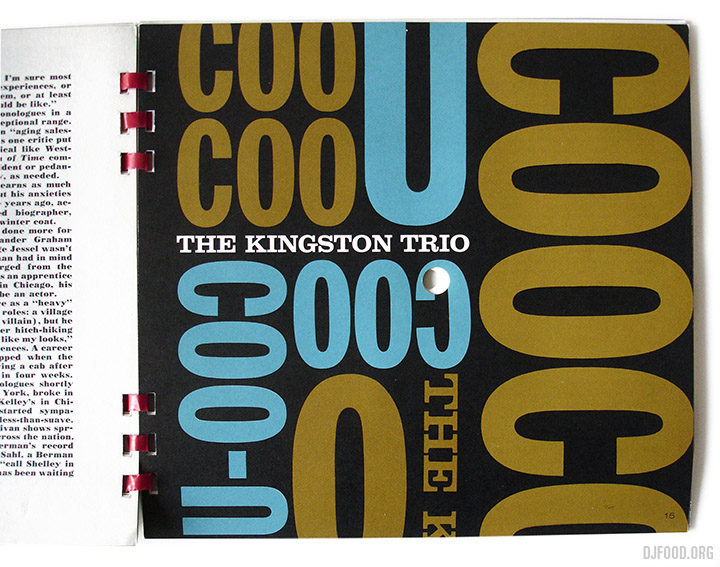

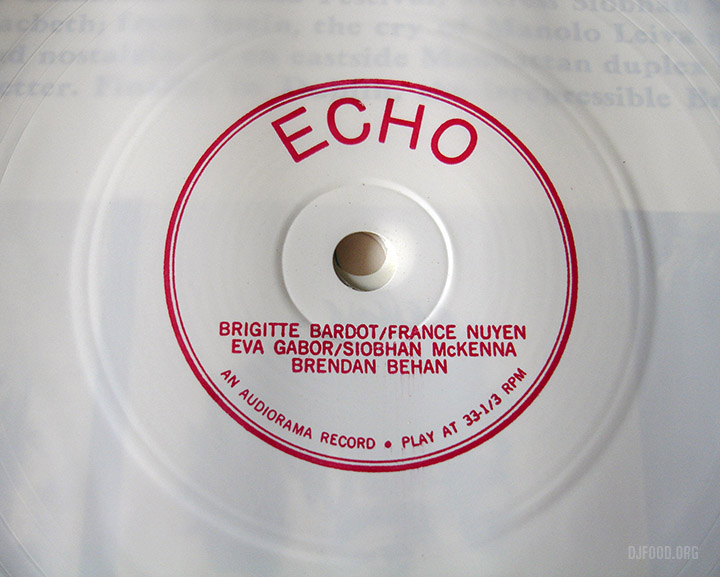
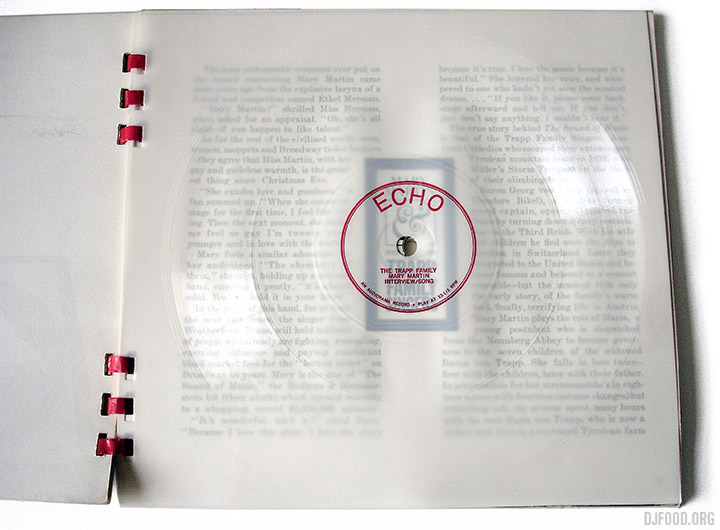
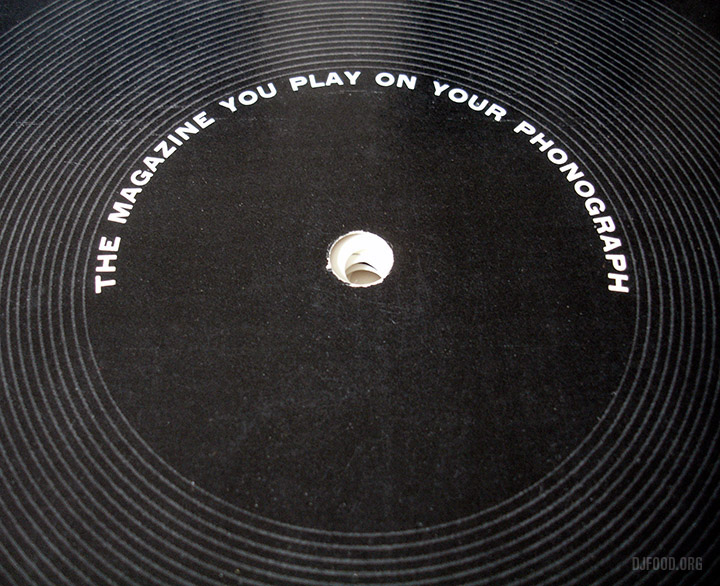
There are some extracts from the discs over on WFMU’s excellent 365 Days Project entry by Katya Oddie for the same issue. Here’s the cover for #2 – pretty advanced design for 1959 – if anyone has any of the other issues that they’d like to sell then I’m interested.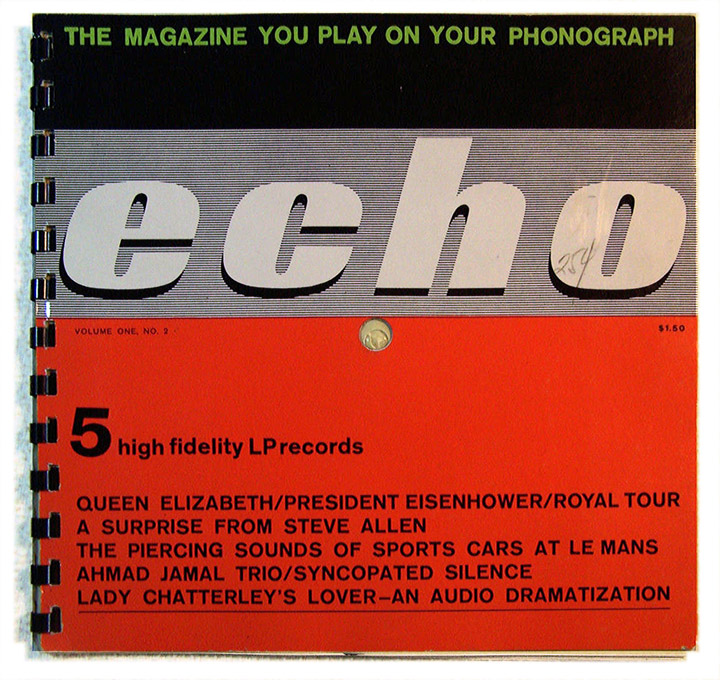
Flexibition
An occasional posting of rare, odd, weird or interesting flexi discs from my collection, guest contributors feature too
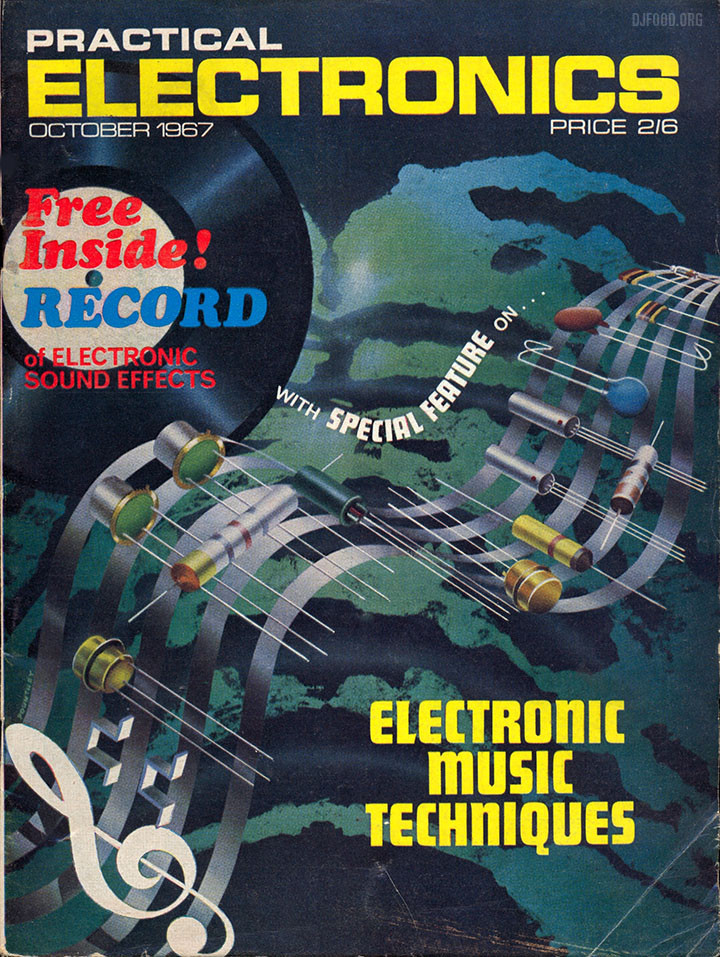
It’s been a while since we’ve had a guest post in the Flexibition and we celebrate the half way mark with Jonny Trunk, someone who should be no stranger to readers of this blog. We start a run of flexi’s given away with magazines with a minor classic of the genre and a treasure trove of sample material, I’ll let Jonny give you the lowdown:
“The Practical Electronics flexi by F.C.Judd (F. C. for Frederick Charles) was only available once, with the magazine’s October 1967 issue. F.C. Judd was a regular writer for PE and other home electronic titles and this comes four years after his own Castle Electronic Music 7” series.
Although issued together, it’s hard to find the magazine and the flexi together these days. If I recall I found the flexi first in an old brown paper bag at Spitalfields market a few years ago. Cost a couple of quid. I found the bag in a box that had come to the market via a North London auction house. The magazine I tracked down a couple of weeks later through a mag dealer. Again a couple of quid.
The PE ‘Electronic Sounds And Effects For Electronic Music‘ record is one-sided and contains a basic introduction to electronic sounds and electronic music generation – all introduced in fairly serious, dry announcements:” (reminiscent of Peter Cook‘s E.L. Whisty character if you ask me – Kev)
Basic Sound Sources
Pure sine wave, square wave, pulse wave from mulitvibrator, Unfiltered white noise
Electronic Treatment
Ring modulated tones, filtered white noise, pulsed tones, attack and decay
Reverberation Effects
Mechanical reverberation, tape echo, excessive echo, pre-echo
Tape Recording Techniques
Replay speed, replay speed doubled, reversed recording, tape loops
Rhythmic Electronic Music
A specially composed short cue for this disc, utlising a melody for which F.C. Judd was awarded first prize in the 1965 British Recording Contest (professional section).
Judd was an early electronics pioneer (still largely unknown next to his Radiophonic Workshop peers) who contributed the music to the British puppet TV show, ‘Space Patrol’ and, as Jonny stated, released several 7″s of electronic music and sound FX on the Castle label. He also wrote several books including, ‘Electronics in Music’, which was reprinted in 2012.
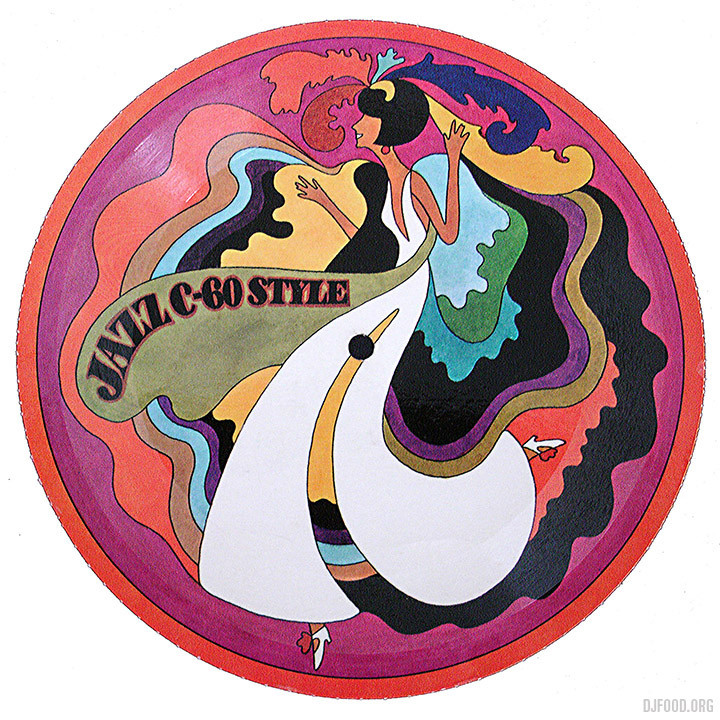
Not so much a flexi but more of a sound card being that the grooves are pressed into cardboard. The sound quality is terrible but it’s all about the graphic here as this was one of the first discs that gave me the idea to do this weekly show and tell. Not much contextual information with this one but the reverse ‘label’ states that the image artist is John Trotta (correct spelling) who did cover illustrations for many classical titles on the Nonesuch label as well as some work for Sesame Street.
He is woefully under-represented on the web it seems, with a style reminiscent of Milton Glaser or Heinz Edelmann. There are also a couple of spelling mistakes on some of the players’ names too, most of them reputable jazz players with many titles under their belts. If anyone can shed any more light on this disc I’d appreciate it.

The Magic Cube is a real oddity – a 9″ flexi disc that comes in a stickered envelope with a flat-packed cardboard cube that springs into shape once opened. Or that’s the idea, you have to attach a fiddly elastic band inside the cube for it to work and even then it’s slightly haphazard in shape, leaving you wondering, ‘why?’. It’s a clever bit of paper engineering but its only purpose seems to be to carry the track list for the disc it arrived with (it’s too small to fit the flexi inside).
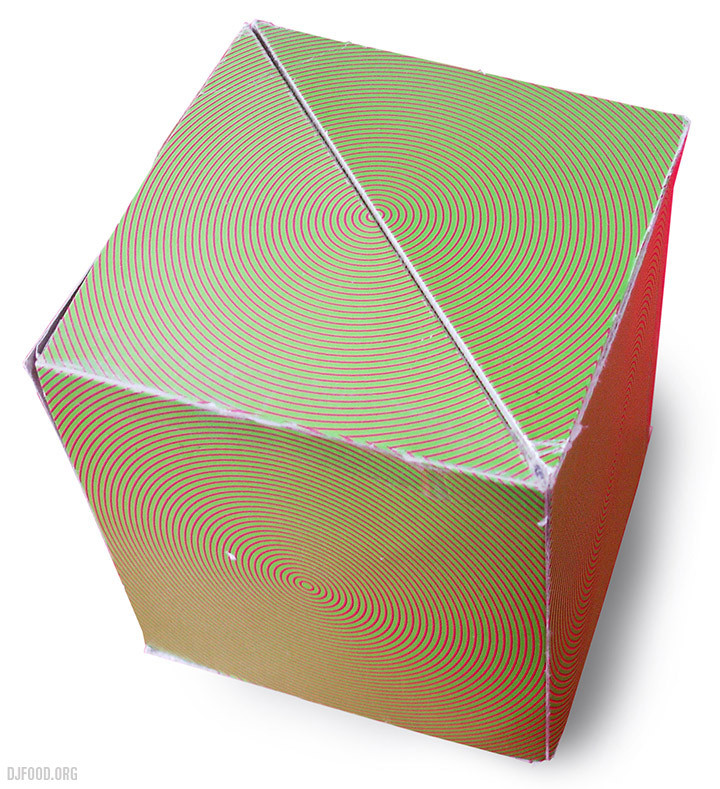
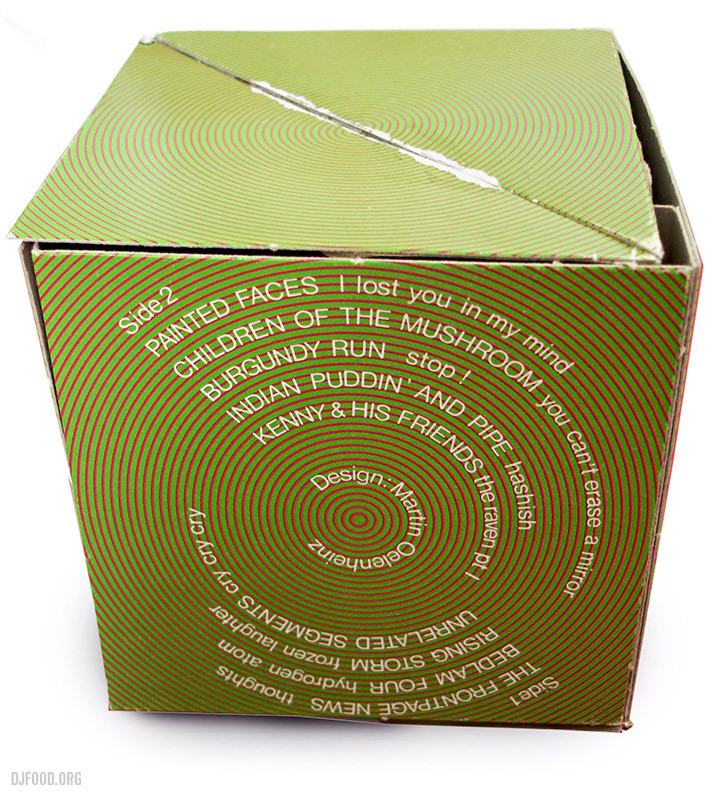
Designed by Martin Oelenheinz and released in 1982 with a sticker stating ‘9 Psychedelic Greats plus Mind-Blowing Gimmick’ and a hand stamped number for the edition (mine is a bit worse for wear). There’s virtually no info about it on the web and the only label info is Eva-Tone. The music contained on the double-sided disc is full on fuzzed out 60s garage and psych rock as you can probably tell by the titles above. Most of the tracks are on YouTube and it’s all pretty great stuff. Anyone with any more info please post in the comments, I’d like to know where this was first available and who / why / what the thinking was behind it.

This sampler, given away free with the NME in 1973, isn’t in here because it’s rare but because of the beautiful sleeve. A mini replica of Emerson, Lake & Palmer‘s ‘Brain Salad Surgery’ album cover, complete with HR Giger paintings and fold out, die cut cover, that’s some promo budget being blown there. 
The first track, the song ‘Brain Salad Surgery’, didn’t actually appear on the album of the same name but was first released on this flexi and later used as the B-side of the ‘Fanfare for the Common Man’ single. Fun fact: the title phrase is apparently a euphemism for fellatio.
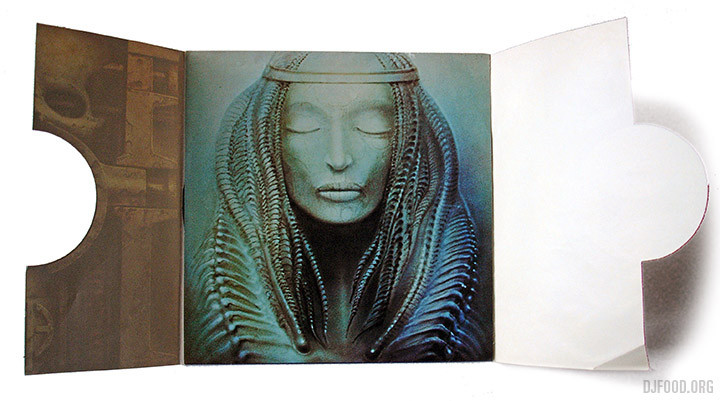
What’s hard to find is a good condition copy without any folds or tears as the cover is just paper rather than card. As for the music, I’ve got to say, I’m more a fan of the sleeve than the music inside it even though it has it’s moments. Here’s some more info about the making of the cover from HR Giger’s website.
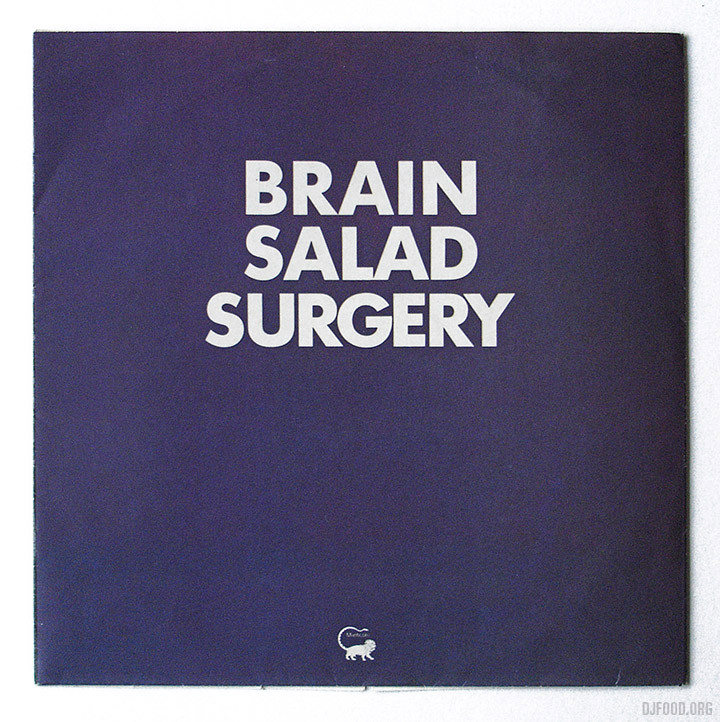
Originally released with issue 2 of the Beastie Boys’ Grand Royal magazine and later to be found on their ‘Sounds of Science’ Anthology compilation. The Biz stars on his own solo Grand Royal release, presumably backed by the Beasties, with the most rambling, drunken cover of Elton John‘s ‘Bennie & The Jets’ you’re ever likely to hear.
I once made the mistake of playing this version out in a club at the end of a night, thinking it was hilarious and everyone would get the joke. It didn’t go down as I expected. Here’s a live version of it being performed by Biz and the Beasties if you’re a glutton for punishment – warning: naked Biz-flesh!.
Staying with Ninja Tune this week, here’s Kid Koala‘s entry and, as ever, he’s doing it his way. Not only is the flexi only 5″ in size but it comes with a construct-it-yourself hand-powered turntable! Free with early copies of his ’12 Bit Blues’ album this features a track, narration and scratch parts – possibly the shortest ‘battle record’ ever. There was also a competition on the album’s release to win a Rane TTM62 mixer with contestants asked to upload their best routines using the parts on the flexi. I’ve no idea who won but it’s the kind of thing only Eric San could dream up.

Here’s a short advert for the album with the turntable animatedly building itself…
…and here’s the full audio from the disc
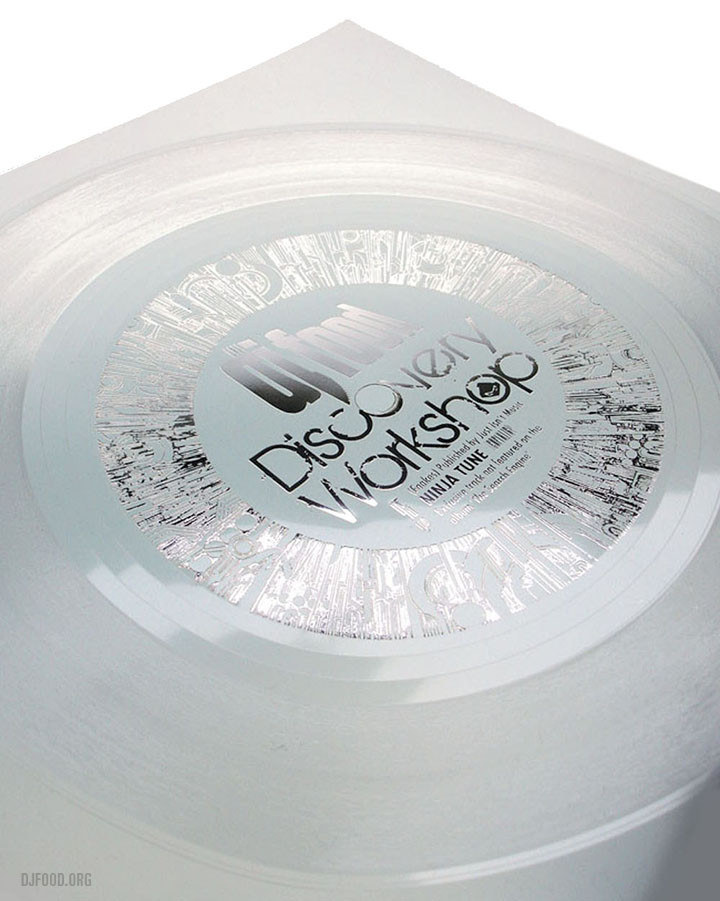
An easy one this, my own entry from the limited edition ‘comic book’ edition of ‘The Search Engine’ album package. I always wanted to do a flexi disc with my own music on but they stopped manufacturing them right around the time I was getting round to it. Wind forward a decade and I have an album and a reason to make one just as they are coming back into circulation. It seems fitting that this track’s title was pinched from another flexi disc in the first place, a happy coincidence rather than forward planning. I felt that the track didn’t fit on the album but wanted to include it somehow, especially with its reference to “a little short playing record like one of these”.
This little short playing record is transparent with silver print and was stapled inside the book version of the album with a serrated edge which could be torn to remove the disc. I don’t recall exactly how many there are but they appeared in the first batch of books and once they were gone that was it so some copies won’t have flexi’s.
Seeing as they originally came in sealed bags it’s hard to tell if buying a new copy. The track did actually appear on the ‘Magpies, Maps & Moons’ EP in exactly the same form so it is available but, truth be told, it’s a bit of a mess, far too much going on, a very confused arrangement. Some kind soul has put it up on YouTube and gone to the trouble to edit a video to it with a few NSFW moments too!
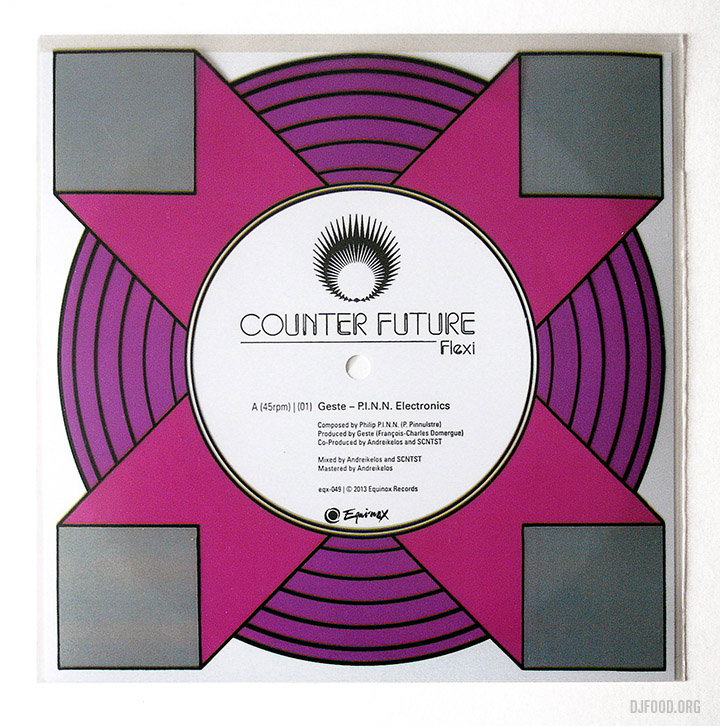
The month of May features some modern flexi discs, several made since manufacturing restarted on them just a few years ago over in North America. Since Eva-tone stopped production in 2001 it seemed virtually impossible to find anyone with the resources to press up flexi discs but they are now readily available through some pressing plants.
As a resurgence in flexi’s started a German record label was sadly coming to an end as Equinox closed its doors in 2013, bowing out with a huge compilation complete with a free soundsheet. And what a beauty it is too, a pure white disc which is housed in a colour, semi-transparent sleeve with the graphic touches that the label always employed courtesy of boss and designer Gunter Stoppel aka DJ Scientist.
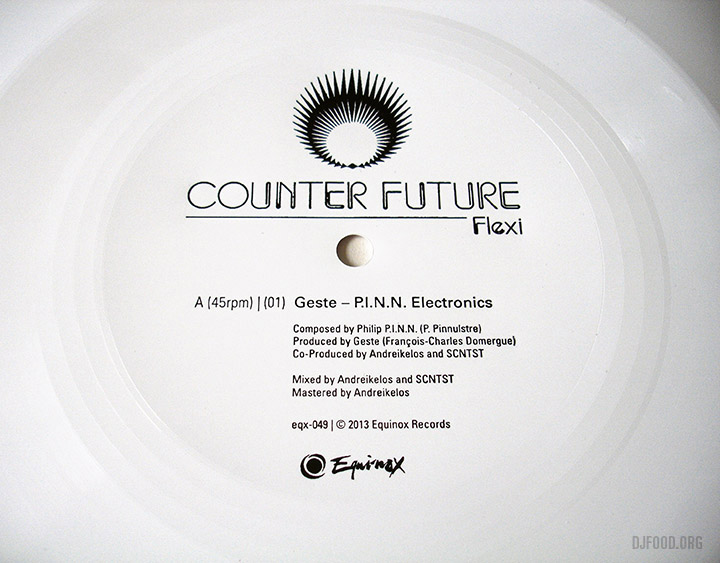
Gunter was one of the first people to contact me when I found a place to press my own flexi disc the year before and our paths had crossed a few times on the subject over the years as he’d been the first person I’d seen to produce playable postcards, something I indulged in too. Not only was a (friendly) competition to see who could find the rarest records, now it was who could make the rarest format!
The disc contained a Geste remix of an obscure track by Philip P.I.N.N. – originally issued on DJ Vadim’s short-living Electro Caramel label, an off-shoot of Jazz Fudge. There’s a long explanation as to why this was chosen to be immortalised on flexible plastic here and you can hear the track below, a feisty, low end electro number and definitely one of the best looking new flexi discs I’ve seen. RIP Equinox Records.
This weeks entry is another special guest post, this time by Markey Funk and Ofer “Schoolmaster” Tal with not one but two picks…
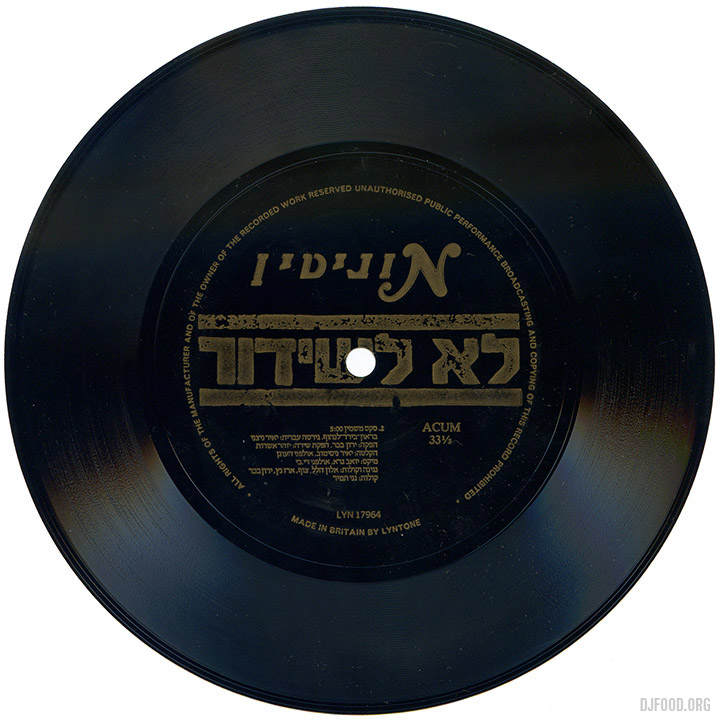
‘Hashem Tamid’ / ‘Sex Mashmin’ (1986, “Monitin” magazine, Israel)
Despite having a well-developed music industry since the early 1950’s, Israel has a very tiny flexi heritage. None of the major record-pressing plants had a proper technology for production of flexi discs. Working with factories abroad made the process slightly expensive for a record that was supposed to be a free bonus. Nonetheless, the 80’s saw quite a few well-known flexi releases in Israel, including an Agfa-sponsored single by Ofra Haza in 1984, a famous Burger Ranch (local fast-food chain) “menu song” lottery, and this special oddity. The story of this weird record goes like Ariadne’s thread through the very labyrinth of the Israeli 80’s popular culture, connecting its distant corners:
In 1984, Yair Nitzani, a keyboard player and songwriter for the extremely popular nonsense pop-rock band T-Slam, joined the cast of “Ma Yesh” – one of the most popular entertainment radio-shows of the decade. He impersonated an eccentric and slightly controversial character – Hashem Tamid (a word play on arab name Hashem, and common Jewish phrase “God is always with you”; check out Coen Brothers‘ “A Serious Man” for a clearer reference) – an arab that tries so hard to assimilate in the higher levels of the Jewish Israeli society, that in the end converts to Judaism. As a side-kick for the radio-show, Nitzani released a few songs by his character. His first song – “Hashem Tamid” – a humoresque “Celebration Rap”-style tune, became, in fact, the first rap song in Hebrew. The music video for the song was broadcast on Israeli Channel 1 in prime-time, which quickly turned it into a major hit, which was even voted a song of the year!
The song was released in minor quantity as a promo 12″ for local radio stations, but became available to public only on this flexi disc, which came as a bonus with the monthly lifestyle magazine “Monitin” (“Reputation”) – a sort of “light” take-off on Penthouse.
The title translates for “Hashem isn’t ours, Hashem is not alone, and is surely not anybody’s sucker.” Actually, this wasn’t even the original version of the song, but a remix!
The single was backed by even weirder B-side: a crazy Hebrew take on James Brown‘s “Sex Machine” – “Sex Mashmin” (“Sex Makes You Fat”), with sloppy and sleazy lyrics and a heavy oriental accent:
The label says “not for broadcast”, I guess that’s because of the content of the song, but the song never had any radio play for a different reason. Both tunes from this flexi, with an addition of some more songs and sketches were collected on a cassette. However, except for a minor run of promo copies of the title song, none of the rest of this material, saw a proper vinyl or CD release. “Sex Mashmin” got pretty much lost between the pages of the magazine, leaving it a “joke that never shot”.
Here’s also a poster from the same issue of Monitin, which says “Not for broadcast. The song that’s forbidden to play on the radio”
Photo by Beit haTaklit, Ramat Gan
Later, Yair Nitzani became a CEO of the major recording company – Hed Artzi. Among his achievements was Ofra Haza‘s major international breakthrough with a mixture of Yemenite songs and modern beat. The first real hip hop record came out in Israel only in the early 90’s…
As a special bonus – and because Avengers 2 just opened and it’s Free Comic Book Day this weekend – Markey has dug out another weird treasure from his collection: the ‘Scream Along With Marvel’ flexi by the Merry Marching Marvel Society which features the theme song for the 1960’s cartoon ‘The Marvel Super Heroes’.
I’d say it’s merits lie in the cover art more than the music but who am I to judge?
Markey is about to embark on a European tour, starting with The Apples in London on May 4th, and then going solo later in the month, catch all the details on his Facebook page.
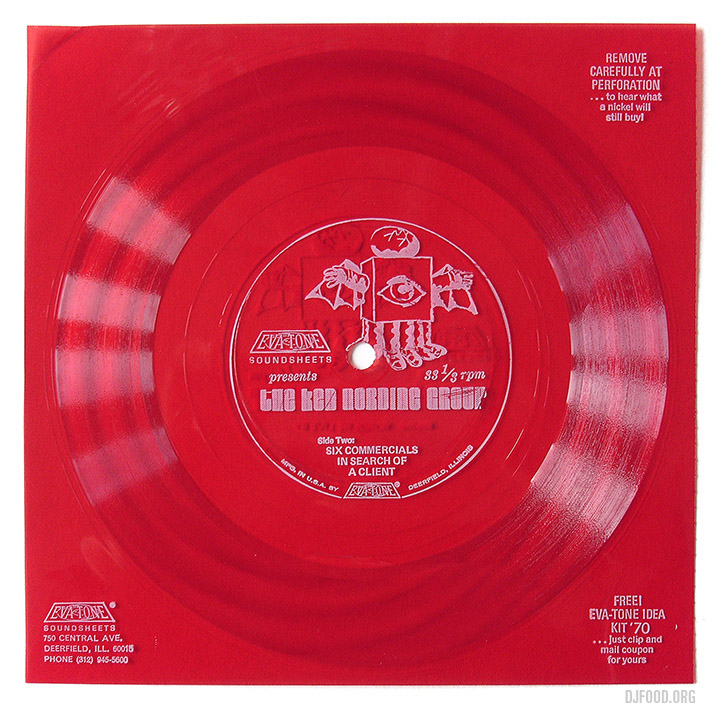
I originally posted this on Otis Fodder‘s incredible 365 Days Project back in 2003 and if you’re not familiar with that treasure trove of weirdness then you’re in for a treat but you have your work cut out for you. This though, is a jewel in the flexidisc crown and always worth hearing again as the lushous tones wonder-wander out of the grooves. A red 7″ flexi produced by the one and only Ken Nordine to show what Evatone promotional soundsheets can do for your company. He goes through six imaginary scenarios all based around what any PR rep would be thinking given such an opportunity, “Why would I want to give such a thing away?” “What will I say?”, “Who will do it?”, “Will they do a good job?”
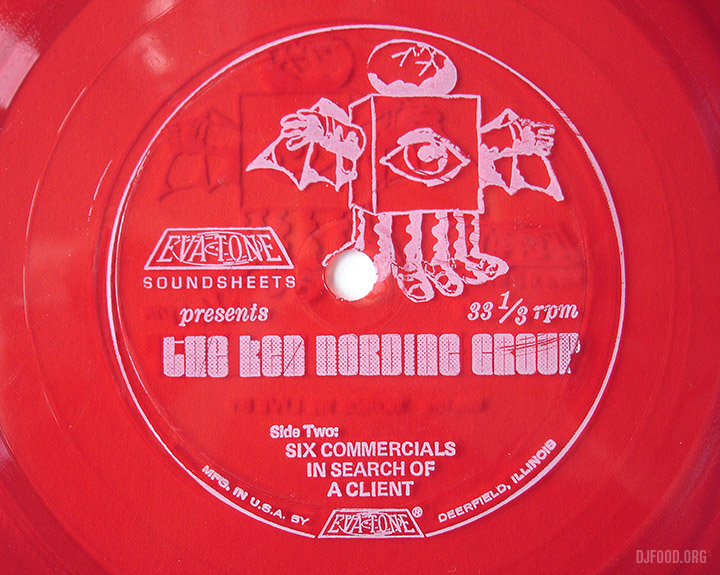
Apparently this originates from 1970-71 and came as a magazine insert and it has ‘Free Eva-Tone Idea Kit ’70’ on the bottom right of the A side so we’ll go with that. Ken mentions that Reagan sent out one and a half million such promo sound sheets, “and look where he wound up“, at one point which originally suggested to me that it might have been later. There are quite a few dents in the flexi so please excuse the audible bumps, I did my best to digitally iron them out.
The A side, ‘Words We Live By‘, isn’t on the web that I can find and, unfortunately, I can’t find the flexi right now but when I do I’ll encode that too.

Dick Clark reviews his memoirs of his lifetime (thus far) in pop & rock music. Nicely placed spindle hole there, maybe he had enemies in the art department?
Included as a bonus record with the ’20 Years of Rock N Roll’ double vinyl compilation release, not a rare find but always nice to see full blown colour flexi’s pressed onto cardboard.

Sticking with the advertising theme for the month of March we have our third guest post in the Flexibition, this time from Pete Issac – he of Jelly Jazz fame and 45 Live co-conspirator alongside Boca 45. He’s chosen a rather groovy flexi from Smiths Crisps by Howard Barnes & Cliff Adams, ‘When It Comes To The Crunch (It’s Smiths IT IS!)’ / ‘Rhythm And Crunch’ (Lyntone Lyn 1021) from 1966. I’ll let him do the talking…
“Do you crunch? You don’t? Well you should. Just send in 3 empty bags and receive your Crunch disc!” So says 60’s radio jock and TV host Simon Dee on the Ready Steady Go-style TV slot from 1966, featuring hipsters of the day throwing what is likely to be ‘The Crunch’ dance moves. A swinging up-tempo mod groove on both sides with the B-side being an instrumental with tight drums and with an even tighter Carol Kaye-esque bass line, in keeping with 60s flavoured bass sounds like the Pete Moore Orchestra‘s ‘Cat Walk’, London Jazz Chamber Group‘s ‘Mae West’ and so on. Completely on point for the period, Smiths Crisps are tapping into youth culture in exactly the same way as marketeers will use pop to sell everything today.
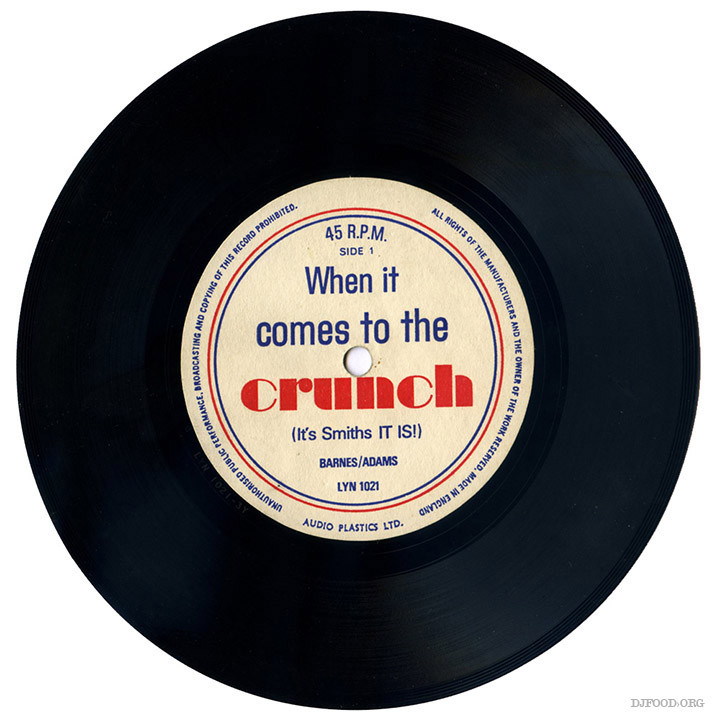
Side 1: ‘When It Comes It The Crunch’
Advertising records were pretty common at the time, and the producer of this, Lyntone, released a bunch of Flexi discs for the likes of Action Man, Ford, Heinz and Cadbury. They also released some Beatles records, which is pretty odd. And the collecting of empty packets to get the record was also common, one of the first records I ever got myself as a youngster in 1972 was by collecting empty Wotsits Crisps packets to get a copy of ‘Wilburs Collection of Childrens Favourites’ (sadly thrown away years ago).
Side 2: ‘Rhythm And Crunch’
This is not a particularly rare/expensive flexi, I picked it up years ago in Plymouth for pennies, and you could easily pick one up on Discogs for a few quid now. But what it is is an evocative promotional piece of music that perfectly illustrates the advertising industry tapping into a relatively newly found audience; young people with disposable income and cultural awareness.
With ‘vinyl’ appearing in almost every TV advert these days, I wonder how long it is before a company rekindles this concept and asks you to send in 30 empty yoghurt pots or wot-not to get a flexi-disc or standard 7″ of ‘Send in The Girls’, or a Mark Ronson ditty or indeed a specially commissioned piece of music. I say to these advertisers ‘hurry up!’.
Smiths Crisps TV Advert featuring the track:
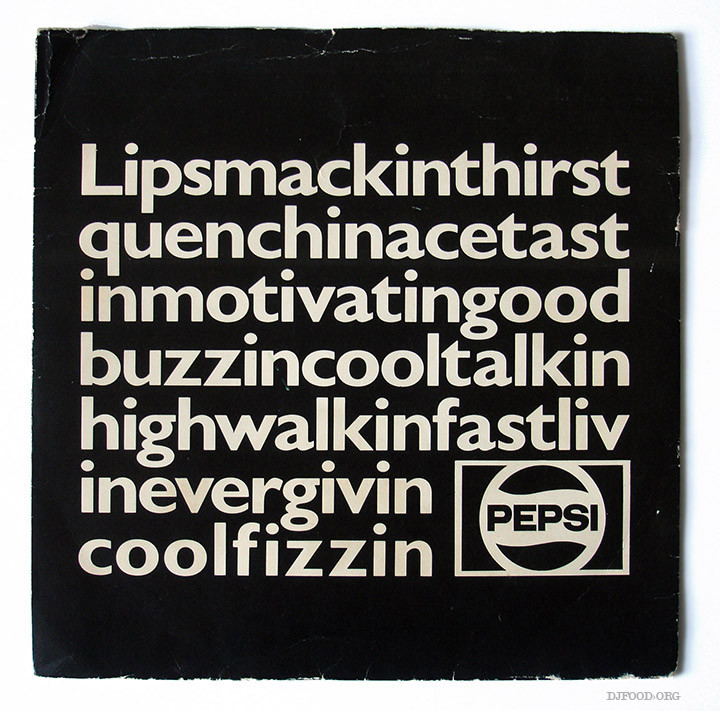 A couple of discs from one of my comedy heroes today in the Flexibition – Kenny Everett – a legendary figure in the British broadcasting landscape from his days on pirate radio to the BBC, making the jump to the small screen on both the Beeb and ITV but never quite making the transition to the big screen. Kenny was one of the most creative disc jockeys on the wireless in the 70s, making endless tape montages of radiophonics, sound FX and song megamixes to intersperse with his wacky comedic range of characters and voices. He was genuinely hilarious and his on-air persona was probably his greatest character of all.
A couple of discs from one of my comedy heroes today in the Flexibition – Kenny Everett – a legendary figure in the British broadcasting landscape from his days on pirate radio to the BBC, making the jump to the small screen on both the Beeb and ITV but never quite making the transition to the big screen. Kenny was one of the most creative disc jockeys on the wireless in the 70s, making endless tape montages of radiophonics, sound FX and song megamixes to intersperse with his wacky comedic range of characters and voices. He was genuinely hilarious and his on-air persona was probably his greatest character of all.
He was no stranger to voice-overs and regularly made jingles for many of the DJs on Capital Radio in his time there. In 1973 he voiced a promo flexi disc for Pepsi’s famous “Lipsmackingthirstquenching…” advert which basically entailed him filling time whilst playing the eight second fizzy drink commercial as many times as possible in four and half minutes. The ad is the gem here rather than Kenny and the disc is notable for having a nicely designed cover which has aged remarkably well graphically and was apparently distributed to retailers of Pepsi to further boost sales.
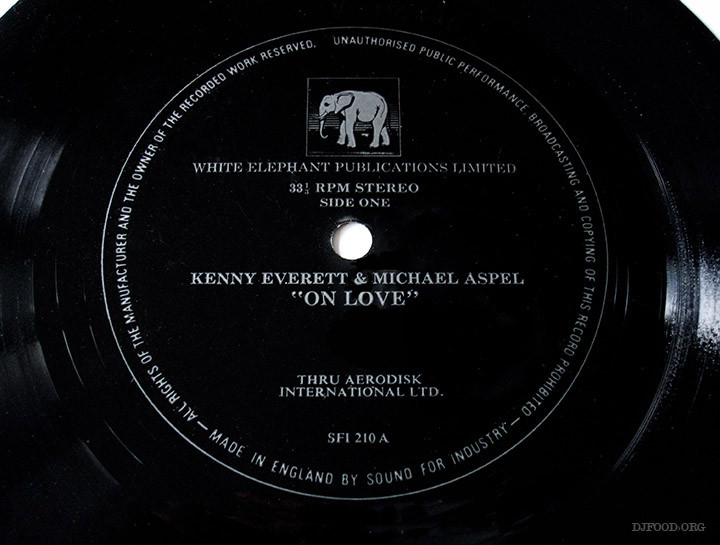
The second of the featured flexi’s is a double act of Kenny and Michael Aspel ruminating ‘On Love’. Aspel of course has to play the straight man (as did anyone who teamed up with Everett) reading from a script but gets in a good few jibes as cuddly Ken shoehorns in as many freestyle double entendres as possible but mainly cracks up. The pair once hosted shows that were the antithesis of each other on the radio, endlessly goading one another on air during the handover between their respective slots, eventually forming a lasting friendship and admiration. Kenny adored the sound of Michael’s voice and he, Kenny’s ability to make him “laugh like a drain”, regularly giving him the giggles on what should have been a serious show.
The intro to the flexi is slightly NSFW and there’s a very odd remark from Aspel in relation to his daughter… It does, however, end with a Rod McKuen-esque dialogue / song that builds to a somewhat unexpected but hilarious crescendo. Dating from 1974, I’m uncertain where this was from or what it was for as there seems to be no information about White Elephant Publications on the web. The disc is backed by Dick Emery with a version of his signature catchphrase, ‘You are awful, but I like you’ transposed into song form. This was also released as a regular vinyl 45 and even made the UK charts at one point that saw Emery making an appearance on Top of the Pops. Much like it’s title, it’s awful.
Two things that I didn’t know about Kenny that I found whilst researching this piece:
He was sacked from Radio 2 in the early 80s for reportedly saying, “When England was a kingdom, we had a king. When we were an empire, we had an emperor. Now we’re a country, and we have Margaret Thatcher.”
He was the voice of the cat in the famous ‘Charlie Says’ commercials.
and one for Dick Emery:
He voiced several characters in The Beatles‘ 1968 animated classic Yellow Submarine including “The Nowhere Man” Jeremy Hillary Boob, the Mayor of Pepperland and Max, one of the Blue Meanies.
RIP Kenny Everett & Dick Emery
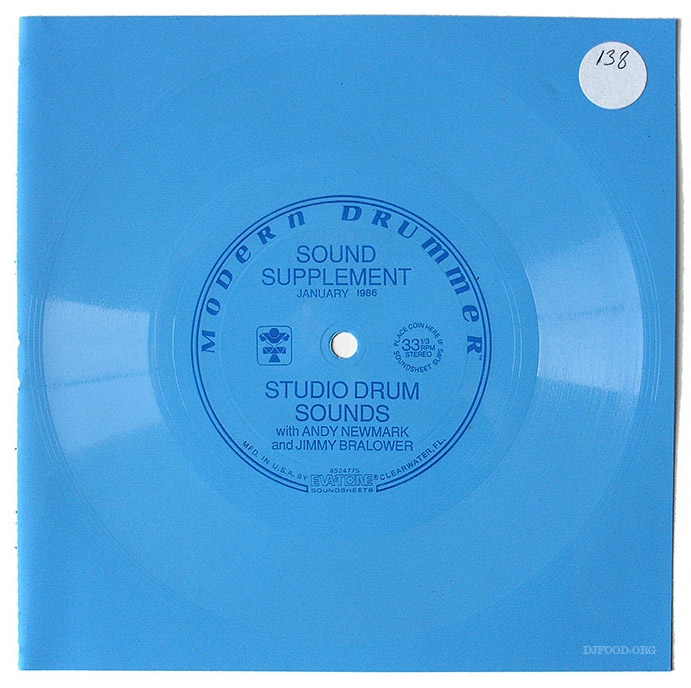
The 10th anniversary issue of Modern Drummer magazine, dated January 1986, came with a free flexi disc containing lots of studio recorded drum beats all mic.ed up differently. An announcer (Andy or Jimmy?) talks you through numbered patterns with various sounds achieved by either mic placement or effects, presumably gone into in detail inside the mag.
Being that this is the mid 80’s the gated reverb technique is in full effect on some of these breaks and it’s sad to say that most of them lack that all important funk that such a disc ten years earlier might have contained. As there was no audio on the web I’ve encoded this and cleaned it up a bit so you can pretend to be Phil Collins or Duran Duran circa ‘Wild Boys’. There were copies of this on eBay recently and it’s listed on Discogs so can’t be hard to find.
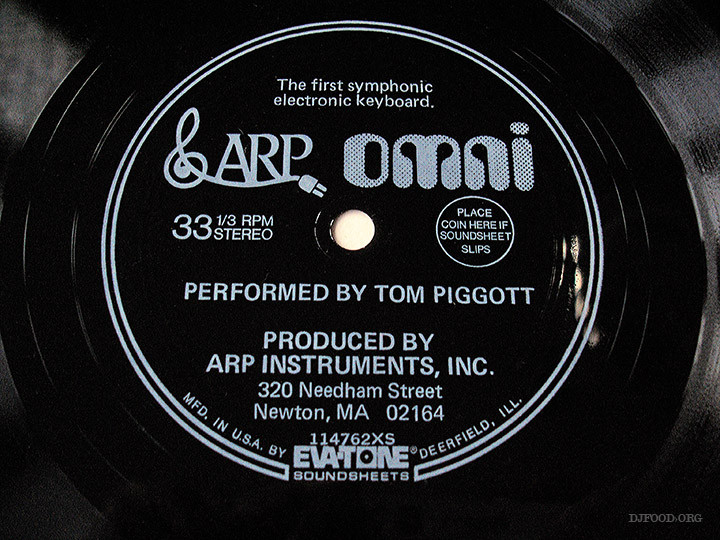 We continue the technology theme this month with another classic synth, the Arp Omni. Billed as ‘The first symphonic electronic keyboard’ this was the best-selling keyboard that Arp Instruments ever made, debuting in 1976 (information varies, depending what you read) with the Omni 1 which was followed two years later by the Omni 2. Check out Tom Piggot demonstrating all the versatile sounds it can make and suddenly breaking into the melody of Chicago’s ‘If You Leave Me Now’ to illustrate the brass setting.
We continue the technology theme this month with another classic synth, the Arp Omni. Billed as ‘The first symphonic electronic keyboard’ this was the best-selling keyboard that Arp Instruments ever made, debuting in 1976 (information varies, depending what you read) with the Omni 1 which was followed two years later by the Omni 2. Check out Tom Piggot demonstrating all the versatile sounds it can make and suddenly breaking into the melody of Chicago’s ‘If You Leave Me Now’ to illustrate the brass setting.
This dates from 1976 (November 4th ’76 to be exact – Eva-Tone cat. no.s start with the date) and was probably given away with either the keyboard itself or Contemporary Keyboard magazine in early ’77. The excellent Retro Synth Ads blog has an amazing array of printed material for all manner of Arp models as well as many other makes and the ads here are taken from that blog. Below is the double page spread that I believe had the above flexi stapled into it from the Jan ’77 issue of Contemporary Keyboard plus a follow up ad from a month later with a photo of the disc.
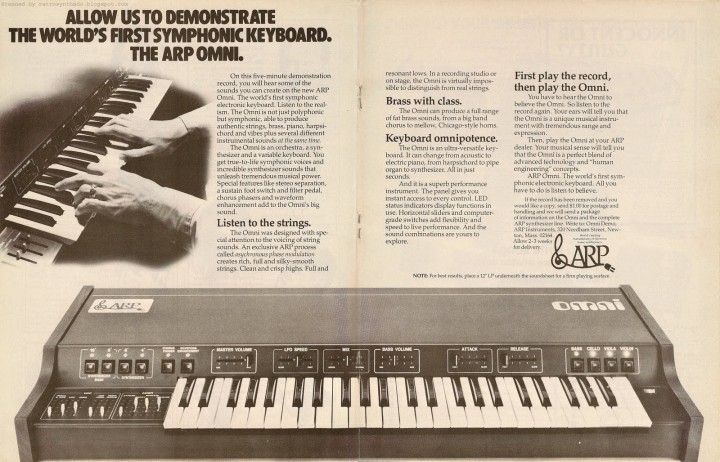
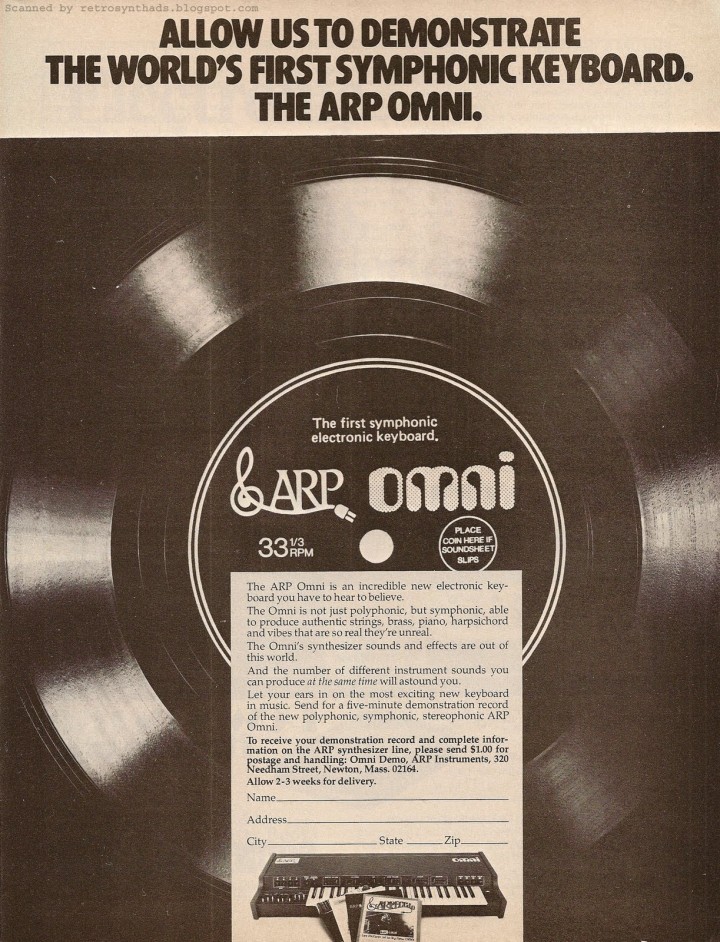 Prepare to spend hours of your life picking through the minutiae of synth memorabilia on Retro Synth Ads (there’s even an Arp belt buckle in there), there are also plenty of sound files to listen to as well. Next week… Drums!
Prepare to spend hours of your life picking through the minutiae of synth memorabilia on Retro Synth Ads (there’s even an Arp belt buckle in there), there are also plenty of sound files to listen to as well. Next week… Drums!
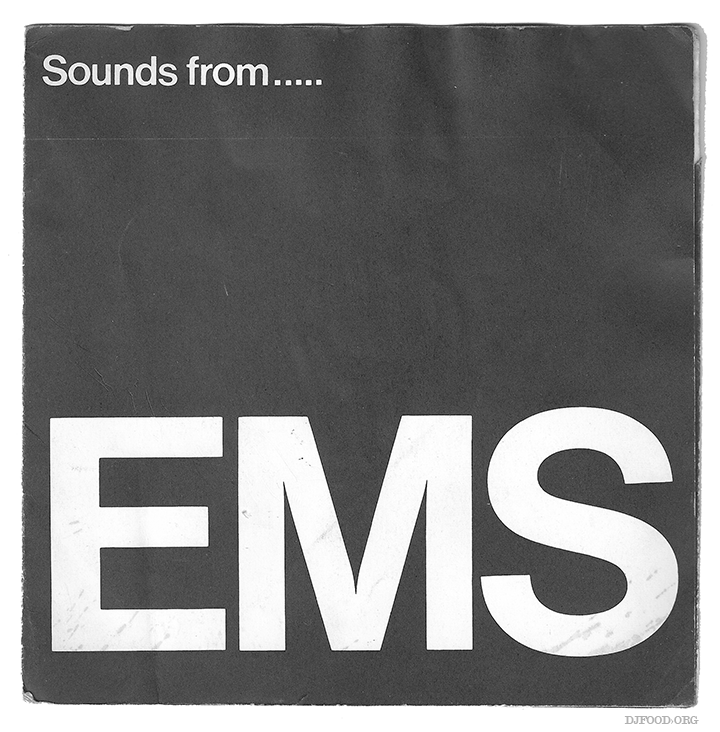 My second guest curator at the Flexibition is Jon Brooks, he of The Advisory Circle, The Pattern Forms and several other aliases, recording for Ghost Box, Clay Pipe Music and his own Café Kaput imprint. I knew about this flexi for a while but never managed to find a copy for myself so, when I was casting around for contributors to the cause Jon was one of the first I thought of who might have a copy. An enquiring tweet was sent out into the ether which was shortly answered with, “actually, yep! I do. One of my favourites of all time.” Bingo! Here’s Jon to tell you more…
My second guest curator at the Flexibition is Jon Brooks, he of The Advisory Circle, The Pattern Forms and several other aliases, recording for Ghost Box, Clay Pipe Music and his own Café Kaput imprint. I knew about this flexi for a while but never managed to find a copy for myself so, when I was casting around for contributors to the cause Jon was one of the first I thought of who might have a copy. An enquiring tweet was sent out into the ether which was shortly answered with, “actually, yep! I do. One of my favourites of all time.” Bingo! Here’s Jon to tell you more…
“Electronic Music Studios are of course the legendary UK synthesizer company, still active under the management of one of the original employees, Robin Wood. Founded in the late 1960s by the trio of engineer / entrepreneur Peter Zinovieff, electro-acoustic genius Tristram Cary and (still vastly underrated) electronics visionary David Cockerell (the person behind the classic Electro Harmonix Small Stone phaser and Akai S900 sampler), EMS created the most celebrated UK-designed synth of all time – the VCS3. These powerful but relatively diminutive instruments were sold by EMS, primarily to fund their research studio; in particular the development of their evolving computer system, which was capable of vastly complex and advanced resynthesis methods.
This promotional flexi, “Sounds From EMS” was produced in the early 1970s to showcase the capabilities of their Synthis and given free to prospective clients. Tristram Cary conducts the proceedings in a very charming way, but cuts a fairly unlikely figure as a salesman, it has to be said… which just adds to the charm. He tempts everyone from rock musicians, avant-garde composers to kids experimenting in classrooms (probably) into buying VCS3s, by playing selections from David Vorhaus, various Radiophonic Workshop composers (yes, Delia is included, also Malcolm Clarke and Brian Hodgson) and the EMS composers’ own work – extracts from both Tristram Cary and Peter Zinovieff are both present here. Even their famed resynthesis computer makes an appearance at the end of side two.
I feel really lucky to have a copy. It was given to me some years ago by my friend (and multi-discipline artist) Wayne Burrows. Wayne has a real knack for finding these kinds of gems and occasionally he sends over a random package of curiosities, which is always a delight – a few of my most treasured records have come from Wayne.
It’s an extremely evocative record for me. It somehow gives me an insight into what the EMS studio at Deodar Rd may have been like to visit. Through this and a few historical photos floating around the web, I can imagine how the studio looked, sounded and perhaps smelled – the warm electronic components heating up every day as the sessions took place. I think it’s a really important little slice of electronic music history.”
For those without a copy, the audio is thankfully available here:
– Jon Brooks.

March is tech month at the Flexibition and I’ll be featuring discs relating to music-making hardware over the next four weeks along with a special guest post. This week’s entry was a precursor to Joe Mansfield‘s beautiful book about drum machines, ‘Beat Box: A Drum Machine Obsession’, released for Record Store Day in 2013. The small 7″-sized, 20 page booklet comes with two flexi discs that feature Schoolly D tracks, ‘Gucci Time’ (Demo) and the classic, ‘PSK’, both remade on the Roland TR-909 by Mansfield.

 Schoolly also narrates and highlights the various sounds of the machine in what comes across as the ultimate nerd-out instructional demo. The booklet is packed with photos, schematics and history relating to the famous drum machine in the same style as the book it accompanies and it’s one of the best designed flexis I own. The cover states that it’s volume.1 but as yet there don’t appear to be any more forthcoming aside from the 808 7″ featured with the deluxe edition of the book, let’s hope Joe at least manages to produce flexi’s of the DMX and the Linn at some stage too. You can still find copies of this beautiful item, try Rarekind Records in the UK or Turntablelab in the States.
Schoolly also narrates and highlights the various sounds of the machine in what comes across as the ultimate nerd-out instructional demo. The booklet is packed with photos, schematics and history relating to the famous drum machine in the same style as the book it accompanies and it’s one of the best designed flexis I own. The cover states that it’s volume.1 but as yet there don’t appear to be any more forthcoming aside from the 808 7″ featured with the deluxe edition of the book, let’s hope Joe at least manages to produce flexi’s of the DMX and the Linn at some stage too. You can still find copies of this beautiful item, try Rarekind Records in the UK or Turntablelab in the States.

I know next to nothing about this but picked it up because of the cover and Dali‘s involvement. According to Discogs it’s a “Short commercial recorded by Salvador Dalí for Crédit Commercial de France (CCF). Sponsored by Publicis. Probably issued in 1967.”
The Continuo blog however thinks it was released in 1971 and describe it thus, “In 1971, the french bank Crédit Commercial de France was selling (not offering) Salvador Dali‘s book L’Apothéose Du Dollar to its customers in CCF agencies all over the country. To promote the book and their customer-oriented financial services they had their advertising agency Publicis create this disc for which Dali wrote a remarkably cynical Dollar appraise. The first part is Dali reading the great poem above. The 2nd part is a bank PR promoting the CCF. The final part is Dali promoting his own book.” All dialogue is in French and the Continuo post contains a transcript of the poem Dali reads.
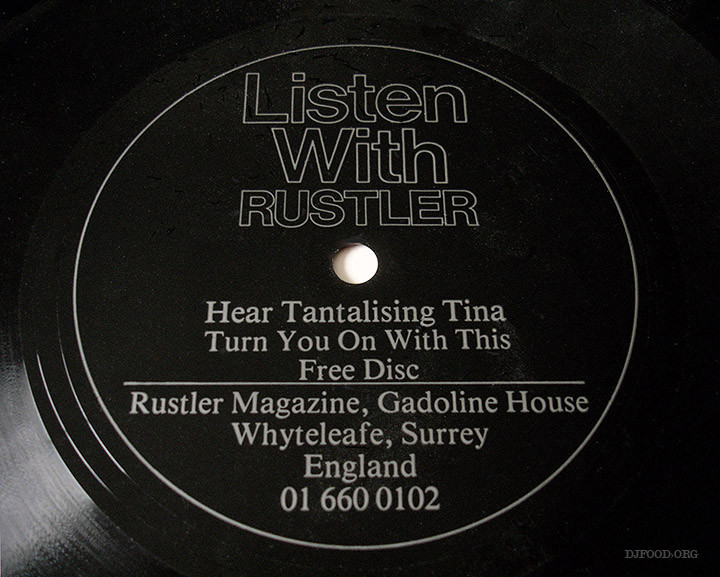
Two very NSFW entries to the Flexibition (or should that be Sexibition? – sorry, that’s even worse) this week. As with many things, sex comes into the equation at some point and flexi discs are no exception. If you’re the proud owner of a copy of Jonny Trunk‘s hilarious ‘Flexi-Sex’ compilation (NSFW link!) then you’ll have heard the first disc here before, originally given away free with a copy of British top shelf men’s magazine, Rustler. No, I didn’t get my copy from there if that’s what you’re thinking, it actually turned up at a record fair and I later made the connection between it and the Trunk comp.
Tantalising Tina was the first in a series of 15 flexis given away over a 3 year period with Rustler and she would later be joined by the likes of Juicy Lucy, Wanton Wilma, Kinky Kelly and Miss Cheeky Chops among others. In true Brit tradition it’s got its tongue firmly in its cheek (no pun intended) and is about as realistic as the Saturday morning wrestling used to be. This is the one where suddenly a man joins in with the charade and pretty much ruins the not-very-good-anyway fantasy that the recording was supposed to induce. Classic 70’s Brit porn. There’s a nice round up of various porn flexi’s over at allvinylexperience, including this one and also at the aforementioned Trunk Records website (Jonny will be contributing to the Flexibition in future too).
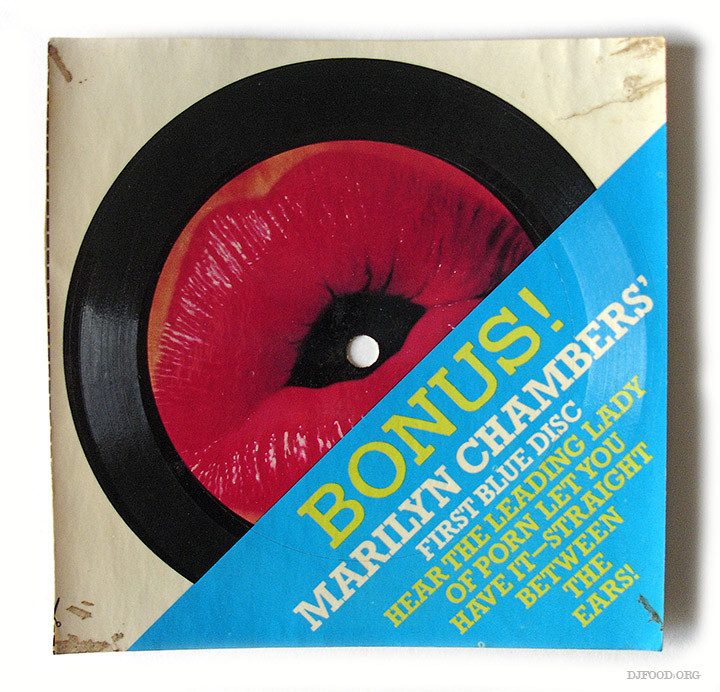
The second inclusion is from the other side of the pond, from a special Marilyn Chambers edition of the American magazine, Club. Marilyn is a bit more earnest in this one, over a cheesy sax-led jazz backing and the funny thing about the recording I found online is that the ending is all messed up and skips, leading to more hilarity. For some reason I can’t embed the audio so head on over to the MotorDudley blog to check it out plus images of the mag it came from.

